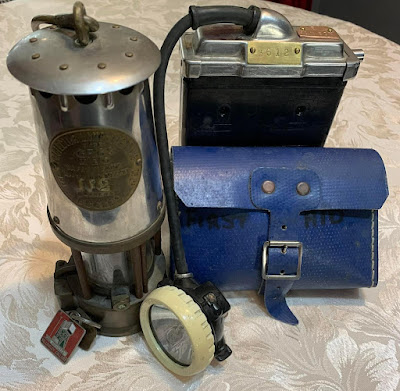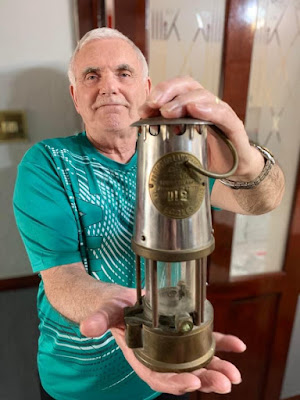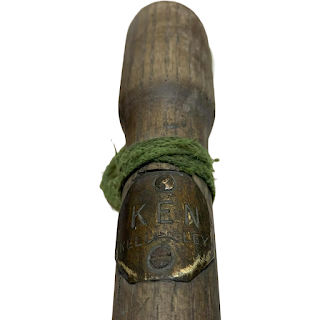Lindsey Hanson from the Wakefield Word Writers' Group has interviewed a very important person indeed - her dad!
Ken Hanson was a Deputy at Ackton Hall Colliery and Kellingley Colliery.
She has written up their discussion in this guest blog.
Ken recalls the everyday work and responsibilities of a Mining Deputy, the good friends he made and one he sadly lost along the way.
Please note: this blog post discusses mining accidents.
 |
| Ken Hanson with some of his mining career memorabilia |
Ken:
I was just fifteen when I left school and wasn't sure what I wanted to do to start with. You didn't have many choices back then with jobs in my neck of the woods, even with decent grades from school.
After a brief stint at mechanics, a Moulder in a place called Resil in Pontefract, and then six months as a Bus Conductor, I started working at Ackton Hall Colliery.
I worked in several pits in the region over the time I was a miner, starting as a General Worker, then a Face Worker, before eventually making my way up to Deputy Grade One.
Training was essential, as it wasn't just coal you had to think about when going down the mine. There were so many safety aspects and regulations you had to be aware of, and to know your first aid in case of accidents. We had what is known as morphine safes down the pits too.
A Deputy would be specially trained in delivering morphine should a serious accident happen.
What was the most important part of the job?
Ken: As a Deputy you oversaw health and safety every shift you were on.
You would go down on your own first (this was known as a 'pre-shift') making sure everything was ok before the men would come down onto the job, making sure there was no methane gas about and everything was ok for them to start work.
We had fans down the pit too, these were our main ventilation, so it was essential they were running correctly (these were also monitored from the surface).
It was a big responsibility resting on your shoulders. All the rest of the men going down the mine after you were trusting you that everything was okay - dads, sons, brothers, best mates.
How were you able to communicate if needed?
Ken: Once you were down there you could ring other places to contact the surface if needs be. These phones were mainly at gate ends and the controls inbye of the gate. |
| Ken's pit check (number 3612) from his time working at the Kellingley Colliery. |
Did you ever encounter an accident? How did you deal with them?
Ken: I was once on shift and a mate of mine was working near a dinting machine, the machine caught the belt that was used to transport muck onto the gate belt. It pushed my mate into the girder at the side trapping him.It was on one of my afternoon shifts where everything was going as it usually would and we would go down the mine, but we noticed the shearer was fast under the face chocks.
“****** that.” I said (that’s mates for you)
No matter how much training you do have, you're never trained for that type of thing.
What was it truly like down there?
The pit itself seems an eerie place for those who haven't been down, but you get used to it.
It never really smelt much down there, but when you were going down in the pit cage that had three levels with 120 men on, and there’d always be one who would start eating garlic on purpose on the bottom level and it stunk the cage out, all in a bit of fun though.
If you turned your lamp off when underground, it was completely black.
You tried to ignore being claustrophobic, it was mind over matter.
You’d eat your snap (lunch) down there too. You would have to do your business down there as well; remember, they were long shifts.
As for uniforms, we had orange workwear the pit supplied, and you could get clean ones every week.
Everyone who went down the pit had to wear a lamp that fitted onto the helmet. The battery for this was worn on your belt. This went alongside a self-rescuer which carried a mask in case of a fire. The mask went into the mouth and a clip was worn over the nose.
Luckily, I never had to use one.
 |
| Ken's oil lamp, lamp and battery to fit to his helmet, and blue first aid bag. |
 |
| A miner's safety helmet with an Edison clip-on lamp and battery attached from our collection. It features in our 100 Years of Collecting Online Exhibition. |
Deputies and some first aiders also carried a first aid bag. These contained basic tackle, plasters and bandages.
Most deputies carried a stick. This was handy when you walked over uneven ground as you can imagine it was pretty rough walking at times!
I also had my stick marked with twelve-inch measures, so you could get a rough idea of the depth of things without getting my tape out.
 |
| Ken's deputy stick, laid out on the table for scale. There are 12 inch measure lines down the length of the stick. |
You couldn’t have an ordinary battery watch down there, it was too dangerous with gases being down there, you had to have a normal wind up one.
Deputies carried what was known as oil lamps, these were used for checking methane gas. If 'one and a quarter' was detected, we had to leave the district immediately.
Did it feel like you were part of a community?
Ken: Banter was good down there, good for morale.We'd love to hear more mining stories from around our district. If you have a story you'd like to tell, please get in touch with us at museums@wakefield.gov.uk.
We've recently installed 'Joining Ranks', a new display at Castleford Museum paying tribute to the women who rallied together during the 1984-85 miners’ strike.



Really enjoyed reading Ken’s story . I’ve known Ken since 1976 when I too worked at Ackton Hall colliery and Ken’s a mate of my brother ( he too ended up being a deputy.) I still bump into Ken and his wife Pat occasionally. Lovely couple.
ReplyDeleteI knew Ken very well and to me being an ex Miner a Deputy, a Safety Officer and a Safety Engineer found the story of Ken time in mining very interesting.
ReplyDeleteGreat stories brings back memories and ken is a lovely fellow
ReplyDeleteOur old neighbour Philip ( Phil or Pip ) worked there too he was from Hemsworth
ReplyDelete